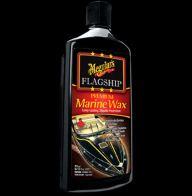Yacht Maintenance Tips for your Yacht Finish
Most yacht owners rely heavily on professional yacht maintenance in order to keep their boat in pristine condition. It doesn’t have to be costly in order to care for your yacht’s exterior condition if it is done as a regular program. It certainly costs a lot more (both in terms of what it takes to regain the finished condition and the lost value if you let it slide. Here are a few yacht maintenance tips learned over a lifetime of experience to help keep your yacht looking like new!
Gelcoat Finished Yachts
Many fiberglass yachts have a gel coat finish; which is a sprayed plastic-like surface. Gel coat is very durable, however it is also very porous and subject to oxidation (cloudiness). As yachts get larger (over 90’), yachts typically convert to a painted finish. However, many popular yachts above this size (which are primarily built in Taiwan) have a gel coat finish. Gel coat requires plenty of protection, especially in sub-tropical areas (such as Florida south through the Caribbean). Good yacht maintenance starts here!
Keep it clean
-
Rinse off the salt whenever you come in from a trip where salt spray gets on the finish. Salt is very corrosive…not so much to gel coat, but every metal object. When it rains, note the direction the rain comes through. In Florida, we note that rain coming in on cold fronts from the northwest often contain large amounts of dirt and pollutants which bury into the gelcoat and often hard to get out! Southerly and ocean-borne breezes tend to pick up water in the clean offshore waters making the rain pollution free.
Wax it Regularly!
 Have the yacht maintenance program include the boat being washed using a wax-friendly soap – such as Orpine or Woody Wax. These won’t strip the wax and protective agents. Also a soft brush head ( we use a Shurhold extendable pole with a soft brush head) tends to clean much better and is better for the surface finish.
Have the yacht maintenance program include the boat being washed using a wax-friendly soap – such as Orpine or Woody Wax. These won’t strip the wax and protective agents. Also a soft brush head ( we use a Shurhold extendable pole with a soft brush head) tends to clean much better and is better for the surface finish.- Wax types are important! Good cleaner waxes, such as Mequire’s #50, Mequire’s Flagship or Collinite’s Fleetwax are excellent choices for cleaning while protecting! However, a properly polished surface with a regular schedule of Insulator Wax (Meguire’s or a number of other products) will last longer. In our Florida climate, it is recommended to wax the surfaces above the rubrail (and transom) every 3 months. The more perpendicular the surface to the sun the finish is…the more abuse it gets from UV. Thus, the hull sides and shaded vertical surfaces less frequently – shoot for every 6 months.
- Try to wax a section of the yacht every time the boat is washed. This makes it much easier to keep the finish from getting away ….and much less expensive to repair. Most owners are not aware of the importance of waxing and let it run-away from them.
- If the gel coat finish starts to oxidize and a good cleaner wax and buffer don’t clear the ‘clouds’…it is time to consider more drastic measures such as a compounding (with wax being applied over the prepared surface) or even wet-sanding >compound>wax.
Stay on top of crazing or cracks
- Gel coat often forms cracks in certain stressed areas (due to flexing and the brittle nature of gel coat). These cracks need to be professionally repaired by grinding around the cracked area, doing a fiberglass patch and applying a fresh layer of gelcoat – often difficult to mend with a matching coloration. It is highly advisable to obtain a factory match with the original gel coat and keep it refrigerated to slow down the degradation process.
 Painted exteriors need care too!
Painted exteriors need care too!
- Most of the above mentioned care applies to painted surfaces as well….clean, wax and stay on top of cracks or crazing.
- The most popular marine exterior paints used today include Awlgrip, Alexseal, Dupont Imron, and more. Awlgrip is certainly the most popular, however since it is a very hard paint, much care should be exercised so that the top layer can be removed unless properly cared for…resulting in premature failure and a new paint job! It is highly advisable to use the manufacturer’s recommended products with these ‘hard paints’.
- ‘Softer’ paints such as Imron, Awlcraft, Dupont and others are much easier to blend (or feather in) a patch when scratched or nicked. I have found that these softer paints can hold up exceptionally well (and better than the hard paints) if cared for by regular cleaning and waxing.
- Dark paint colors take a beating with the sunlight and UV, especially areas which are perpendicular to the sunlight. This is why most yachts are white in color! If you have to have a darker color …you must maintain it even more than normal, or it will start to fade and require repainting prematurely. There are beautiful milder tones found in all color groups which are much less susceptible to fading…such as mild yellow, beige, green, blue, gray tones. The transom (or back edge) corners are especially susceptible to fading.
Keep the yacht under cover when not in use
Storing a yacht under a shed will greatly reduce the effects of weather and sunlight when not using your yacht regularly. Many yachting communities have boatyards with sheds which allow the yacht to be stored under cover. Not only will the cleaning be easier, but the wax will hold up much better. Plus, they are better for storm protection. I recommend concrete reinforced sheds for this reason (and no rust flaking found on most steel roofed sheds).
Savvy boat owners (and buyers) recognize a well-kept yacht by the condition of the exterior as first impressions mean everything to a well-heeled buyer. Don’t let your exterior finish get away from you! Ensure that your yacht maintenance program starts with your exterior finish protection.
Ak Yachts often acts as a custodian for yacht owners which may live out of town. Please contact Andy Kniffin at (954) 292-0629 cell or andy@akyachts.com for any information and referrals regarding this article.





